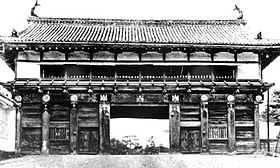Aoba Castle
| Aoba Castle Thanh diệp thành | |
|---|---|
| Sendai,Miyagi Prefecture,Japan | |
 Reconstructed Wakiyagura of Aoba Castle | |
| Coordinates | 38°15′09″N140°51′22″E/ 38.252478°N 140.856156°E |
| Type | hilltop-styleJapanese castle |
| Site information | |
| Open to the public | yes |
| Site history | |
| Built | 1601 |
| Built by | Date Masamune |
| In use | Edo period |


Aoba Castle(Thanh diệpThành,Aoba-jō)is aJapanese castlelocated inSendai,Miyagi Prefecture,Japan.Throughout theEdo period,Aoba Castle was home to theDate clan,daimyōofSendai Domain.The castle was also known asSendai-jō(Tiên đài thành)or asGojō-rō(Năm thành lâu).In 2003, the castle ruins were designated aNational Historic Site.[1]
Design
[edit]Aoba Castle is located on a plateau overlooking the city of Sendai on the opposing bank of the Hirose River. The site is protected by cliffs to the south and east, and by a deep forest to the west. This forest was strictly guarded in theEdo periodand is a rare survivor of the original virgin forests inHonshū.The area is now managed as a botanical garden byTohoku University.
The castle hill is partially surrounded by the Hirose River to the north and east, and a steep slope protects the south. TheHonmaru(inner bailey) is about 115 meters high, and is a roughly square-shaped area 250 meters long surrounded by stone walls, in some places 15 meters high. It contained the foundation for thetenshu,(equivalent to themain keepofEuropean castles); however, only the foundation base was ever built. Instead the Honmaru was protected by four 3-storyYagura.Thedaimyōresidence within the Honmaru was built in the flamboyantMomoyama-styleand contemporaries compared it withToyotomi Hideyoshi's legendaryJurakudaiPalace inKyoto.North of the Honmaru was the Ni-no-maru (Second Bailey) and the San-no-maru (Third Bailey), followed by an area containing the residences of the highest samurai officials of the domain. The Ni-no-Maru was used for both governmental functions and was the location of the main residence of thedaimyō.The Honmaru was reserved only for certain ceremonial functions. A bridge across the Hirose River led to the Higashi-no-maru (East Bailey), which also had the Ōte-mon (Main Gate) of the castle.
History
[edit]The site of Aoba Castle, a small hill called “Mount Aoba” was the site of a fortified residence of a branch of the Shimazu clan, the nominalkokushiofMutsu Provincefrom the earlyKamakura period.In theMuromachi period,it was controlled by theJi-samuraiKokubun clan, which was in turn destroyed by the Date clan.
Following theBattle of Sekigahara,in 1601, the area was visited byTokugawa Ieyasu,who renamed “Mount Aoba” as “Sendai”. The firstdaimyōof Sendai Domain,Date Masamunebegan construction of the castle with theinner baileyand San-no-Maru bailey at the base of the hill. Work on the castle, including the San-no-Maru bailey and numerous gates was completed byDate Tadamunein 1637.
After completion, castle served as the headquarters of the Date clan and administrative center ofMutsu Provinceunder theTokugawa shogunate.
The castle was destroyed repeatedly by earthquakes and fires, notably in 1616, 1648, 1668 and 1710. More than six major earthquakes occurred between 1710 and 1868, but there is no record of major damage.
During theBakumatsu period,the castle was one of the nerve centers of theŌuetsu Reppan Dōmeiduring theBoshin War,asDate Yoshikuniwas leader of the pro-Tokugawa alliance. Taken over by theMeiji governmentin the aftermath of Sendai's surrender, it was partially dismantled in the 1870s, and the grounds were given over to theImperial Japanese Army,who used it as the base for the Sendai Garrison (later theIJA 2nd Division). A large fire in 1882 destroyed many of the remaining structures of the castle.
In 1902, aShinto shrine,theGokoku Shrine(Hộ quốc thần xã,Gokoku-jinja)honoring the war dead, was established. In 1931, two of the few remaining structures of the castle, theOmotemonGate and theWakiyaguratower, were designated asNational Treasuresby the Japanese government. However, these structures and all else in the castle were destroyed completely on July 10, 1945, by the United States during theBombing of Sendai during World War II.
During theoccupation of Japan,the castle site came under the control of theUnited States Army,which razed any remainingEdo periodstructures. It was returned to Japan in 1957. In 1961, theSendai City Museumwas built on the site of the San-no-Maru enclosure. Over the next decades, stone base, some walls, and some wooden structures, have been rebuilt to increase the tourist potential of the site, and in 2006, Aoba Castle was designated one of the100 Fine Castles of Japan.
Literature
[edit]- Benesch, Oleg and Ran Zwigenberg (2019).Japan's Castles: Citadels of Modernity in War and Peace.Cambridge: Cambridge University Press. p. 374.ISBN9781108481946.
- De Lange, William (2021).An Encyclopedia of Japanese Castles.Groningen: Toyo Press. p. 600.ISBN978-9492722300.
- Schmorleitz, Morton S. (1974).Castles in Japan.Tokyo: Charles E. Tuttle Co. pp.144–145.ISBN0-8048-1102-4.
- Motoo, Hinago (1986).Japanese Castles.Tokyo: Kodansha. p. 200 pages.ISBN0-87011-766-1.
- Mitchelhill, Jennifer (2004).Castles of the Samurai: Power and Beauty.Tokyo: Kodansha. p. 112 pages.ISBN4-7700-2954-3.
- Turnbull, Stephen (2003).Japanese Castles 1540-1640.Osprey Publishing. p. 64 pages.ISBN1-84176-429-9.
References
[edit]- ^"Tiên đài thành tích".Cultural Heritage Online(in Japanese). Agency for Cultural Affairs.Retrieved25 December2016.
External links
[edit]![]() Media related toSendai Castleat Wikimedia Commons
Media related toSendai Castleat Wikimedia Commons



